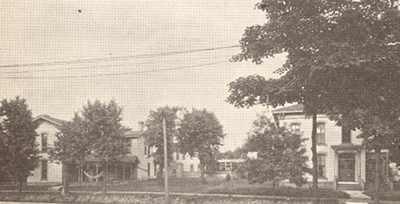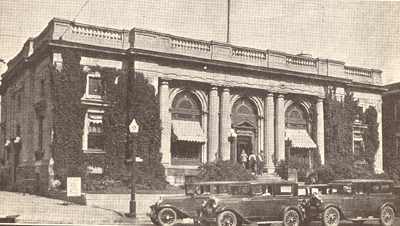|
A
hundred years of history of the Decatur
postoffice is another story of a century of
progress of the city.
If Daniel McCall, Decatur's first
postmaster, in 1830, and J. H. Hill,
Decatur's postmaster in 1930, could get together
and compare notes, it no doubt would be an
interesting session. Suffice to say, that
the job of a postmaster in the year 1930 is a
far cry from the same job in 1830. If the
first postmaster could take a peek into the
Decatur postoffice some time just before
Christmas now, and could see the stacks of mail
piled high, he would probably suffer a collapse.
From the occasional letter which came a
hundred years ago, the postal business in
Decatur has grown to an enormous figure.
Postoffice receipts for the year 1929 were
$409,874.25.
A hundred years ago one man could handle the
postmaster's work and four or five other
official positions, and still not be a busy man.
Today it takes the full time of scores of
government employees to do the work.
Decatur's first postmaster received his
appointment March 6, 1830. The postal
business was not heavy enough then to require a
special office, and the postoffice was wherever
the postmaster happened to be in business.
Several of the early day postmasters were
storekeepers and naturally took care of the mail
in their stores, usually having a small box
somewhere in which the letters were kept.
Mention has often been made in stories of the
old days to the effect that the postmasters
carried the mail in their hats. It was
true. Often the amount of mail was so
small that a postmaster had no trouble in
finding room in his hat for it, and would use
that method of carrying it, in case he
went to deliver a letter.
One didn't have to "lick the stamp" then when
a letter was sent, for there were no postage
stamps. Goose quills provided the pens.
Ink was home made. People who felt the
need of having blotters used a sand blotter.
It was a metal or tin container, filled with
sand, and the sand was sprinkled over the
written sheet, as one uses a salt or pepper
shaker. The last page of the letter always
was blank, as that formed the page for the
address when the letter was folded and sealed
with sealing wax. Envelopes such as are
used today were then unknown. Ye
correspondent in those days wrote this letter,
folded it with the blank side out, sealed it,
addressed it, and it was ready to go.
All the town turned out when it was time for
the mail to arrive. Not that everyone was
expecting a letter - ah, no - but yet one never
knew what might happen. It wasn't a bad
idea to be around when the mail was distributed,
in case --!
Anyway, the postoffice was a favorite meeting
place for the people. There they would see
their friends. Even if Mrs. Blank didn't
get a letter herself she was interested in
knowing who was fortunate enough to receive one.
One by one the postmaster read the names of the
persons to whom his painfully few letters were
addressed. Then the persons so honored
stepped up and claimed their mail. That
is, they did if they happened to have 25 cents
in their pockets to pay the postage. If
they didn't the letter had to wait.

After postal business grew to the extent that
an office was needed, a room for that purpose
was secured. Since then it has been moved
from pillar to post, occupying various buildings
about the city. Not until the year 1909
when the government building in use today was
occupied has the postoffice had a home it could
call its own.
At the time of the Civil War the postoffice
was located in the room on the site later
occupied for years by the B. Stone
clothing store, in Central block.
Its next location was at the corner of North
Water and East Main street, the drug store
corner.
From there it was moved to North Water
street, 200 block, just north of the entrance to
the Smith Opera house.
Its next move was to South Water street, in
the powers building.
Then the office was moved to the 100 block
East Prairie street, northwest corner of the
alley, where it remained a number of years.
Next time a change was made in location, the
office was moved to the Columbia block on North
Main street.
In 1903 the office was changed to the Manitou
building in the 300 block on North Water street,
where it remained until the new government
building was occupied, early in the year 1909.
Carrier service was given the city in 1884
during the administration of Postmaster R. P.
Lytle. Since that time Decatur ahs had
free delivery.
In 1902 free rural delivery service was
established. W. F. Calhoun was then
postmaster.
NEW BUILDING
It was during Mr. Calhoun's service as
postmaster that the movement was started to
secure a government building for Decatur.
After several years of effort on the part of
postmaster and citizens, it was announced that
Decatur would get such a building. The
site at the southeast corner of North Main and
Eldorado streets was purchased in 1904.
The corner lot, which was 87 by 152 feet, was
bought from C. P. Housum, and 48 feet of
the W. T. Wells property adjoining on the
south also was purchased. This gave the
government a tract 135 by 152 feet for its new
building. Cost of the site was $12,000.

Work on the new structure was started in
1907, and the new building was occupied in
January, 1909. Congress had first
appropriated $80,000 for the building, but later
an additional sum of $30,000 was secured, making
a total of $110,000.
Business of the postoffice has continued to
grow so rapidly that efforts have been made a
number of times within recent years to secure an
addition to the building. More room soon
will be an absolute necessity.
POSTMASTERS SINCE 1830
The list of postmasters in Decatur and the
dates of their appointment since the beginning
is as follows:
|
Daniel
McCall,
March 6, 1830 |
John Ryan,
Sept. 13, 1859 |
|
Isaac C.
Pugh, Oct.
1, 1831 |
Hiram Buck,
Sept. 28, 1866 |
|
Daniel
McCall,
March 15, 1834 |
George B.
Peake,
March 1, 1867 |
|
William
Cantrill,
Feb. 26, 1835 |
William J.
Ursey,
April 5, 1869 |
|
John G.
Speer, May
27, 1837 |
Isaac C.
Pugh,
Sept, 5, 1871 |
|
Wilson
Allen,
Feb. 19, 1840 |
Robert P.
Lytle,
Dec. 16, 1874 |
|
Thomas P.
Rogers,
Jan. 20, 1841 |
Samuel S.
Jack, Jan.
13, 1887 |
|
Samuel C.
Allen,
June 24, 1841 |
John T.
Hubbard,
Jan. 31, 1891 |
|
Alex Mahood,
Feb. 25, 1845 |
Jerry
Donahue,
June 5, 1894 |
|
Preston
Butler,
March 21, 1849 |
William F.
Calhoun,
Oct. 26, 1897 |
|
William J.
Ursey,
Sept. 5, 1851 |
Wilson M.
Bering,
June 27, 1913 |
|
John P.
Post, July
7, 1853 |
Jacob H.
Hill, Jan.
1, 1922 (present incumbant. |
|
Philip B.
Shepherd,
Aug. 27, 1858 |
|
<PREVIOUS> <NEXT>
<CLICK HERE TO RETURN TO TABLE OF CONTENTS>
|